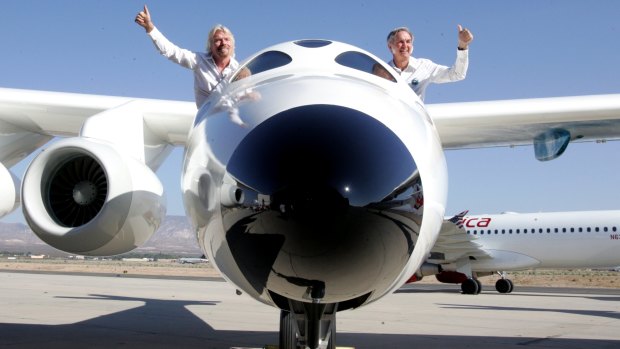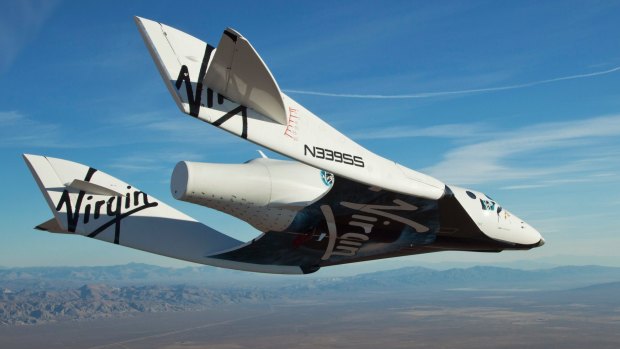This was published 5 years ago
Why space tourism is an incredible waste of money
By Ben Groundwater

Richard Branson, left, in his concept craft, SpaceShipTwo. Credit: AP
Space tourism is here. It's real. It's not some outlandish vision of a distant future. Right now, if you have the money, you can pay to get in a spacecraft and fly around the moon and back.
Of course, you don't have the money. That journey, with a company called SpaceX, costs somewhere in the region of US$100 million, which is not the sort of change many people have to throw around. There's a Japanese man, Yusaku Maezawa, who does have that sort of change to throw around, and will undertake his interstellar journey sometime around 2023. For the rest of us, however, that will remain a dream.
But that isn't where space tourism begins and ends. And for those looking for the next frontier, who are so obsessed with travel that they want to take this thing as far as it can go, the space travel experience is already possible.

The Virgin Galactic SpaceShipTwo, flies over the Mojave Desert in California on a test flight.Credit: AP
The quality and length of your experience just depends on how much money you have to spend.
At the top end of the scale is the SpaceX flight around the moon, and a successful test flight of the "Falcon Heavy" spacecraft last week means the first commercial flight is even closer to reality. You might say it was one small step for a company, and one giant leap for space tourism. Maezawa-san should get himself prepared for a 2023 launch.
Next, for those who are only stupidly rich, there's the chance to spend US$20 million and fly into orbit, before visiting the International Space Station. That Russia-led program is currently on hold, though it's hoped it will be resuming soon. Better start saving.
A flight like that is known as "orbital space tourism", the experience of flying high enough and long enough to leave the Earth's atmosphere and enter orbit. There are several projects currently in the works to offer that experience to paying customers, including a plan to position what would essentially be a very expensive luxury hotel – the Aurora Space Station – in orbit by 2021.
That date seems highly ambitious, but still, it's an interesting concept. The Aurora would be a private commercial space station with a capacity of six people, including two crew. You want a boutique hotel in a remote location with personalised service? This is it.
Still, of course, it will be stupendously expensive – 12-day space adventures will cost US$10 million – so what is there for the rest of us? That's where you need to start looking at sub-orbital space tourism, taking a flight that reaches between 100 and 160 kilometres in altitude, allows up to six minutes of zero-gravity weightlessness, and provides a view of the curved Earth below.
Sounds pretty amazing, and feasible. Unfortunately, however, it hasn't happened yet. Virgin Galactic was all set to launch its first commercial sub-orbital flight by 2015, but unfortunately its spacecraft disintegrated during a test flight over the Mojave Desert in 2014, which was something of a setback.
The company is hoping to launch its first commercial flight – aboard a new spacecraft, the SpaceShipTwo ("Er, what happened to SpaceShipOne…?") – by the end of this year. More than 600 people have so far booked their tickets, at a cost of US$250,000 a pop. This is happening.
That's still not exactly a bargain of course, but it's a lot less than the US$20 million needed to go to the ISS, or the US$100 million to go around the moon. It's miles out of reach for your average traveller though, and still not even worth talking about as a possibility for most people.
Fortunately, there's one more option. This one costs 6000 euros, or about $10,000 Australian. It's expensive, but doable. Most people who like to travel the world could save that much if they really wanted to.
What you'll get for your $10,000 is a total of about five minutes of zero-gravity weightlessness (taken in 20-second bursts as the plane reaches the top of 15 high-speed parabolas) on a two-and-a-half-hour "parabolic" journey. The flight is with a French company called Novespace, aboard a specially fitted-out Airbus A310 that departs from Bordeaux airport.
The company has been running these flights since 2013. There are four journeys scheduled over the next 12 months, with bookings still available.
It's not real space travel, of course. You don't leave the Earth's atmosphere. You don't see a blanket of stars free of the "twinkle" sensation caused by Earth's atmospheric layers. You don't get to stare at the glory of the world from the blackness of space. But you do get to float around an aircraft cabin for five minutes or so and pretend.
The question, of course, is if it's worth it – if any of this is worth it. These are crazy amounts of money we're talking about to conquer travel's final frontier. With that sort of cash you could have a lifetime of truly great adventures back here on Earth.
I used to dream of being an astronaut when I was a kid, just as I'm sure so many people did. And any traveller with a spirit and a thirst for adventure would surely be captivated by the idea of flying into space.
But it's not where I want to put my money. Not for the foreseeable future, anyway. Even with $10,000, the cost of the Novespace zero-g flight, you could do some amazing things. You could travel the world for months. You could see and experience earthly delights that to me are far more exciting than the thrill of floating around an airplane cabin for a few minutes.
Space tourism is here, it's real, and it's pretty exciting if you have far too much money. For the rest of us, however, I think Earth will do.
See also: The ultimate bucket-list experiences for 2019
See also: The top new plane cabin designs for 2019
How much would you pay for space tourism? Is this a dream of yours, or would you prefer to travel the Earth? Is this all an incredible waste of money?
Email: b.groundwater@traveller.com.au
Instagram: Instagram.com/bengroundwater
Sign up for the Traveller newsletter
The latest travel news, tips and inspiration delivered to your inbox. Sign up now.